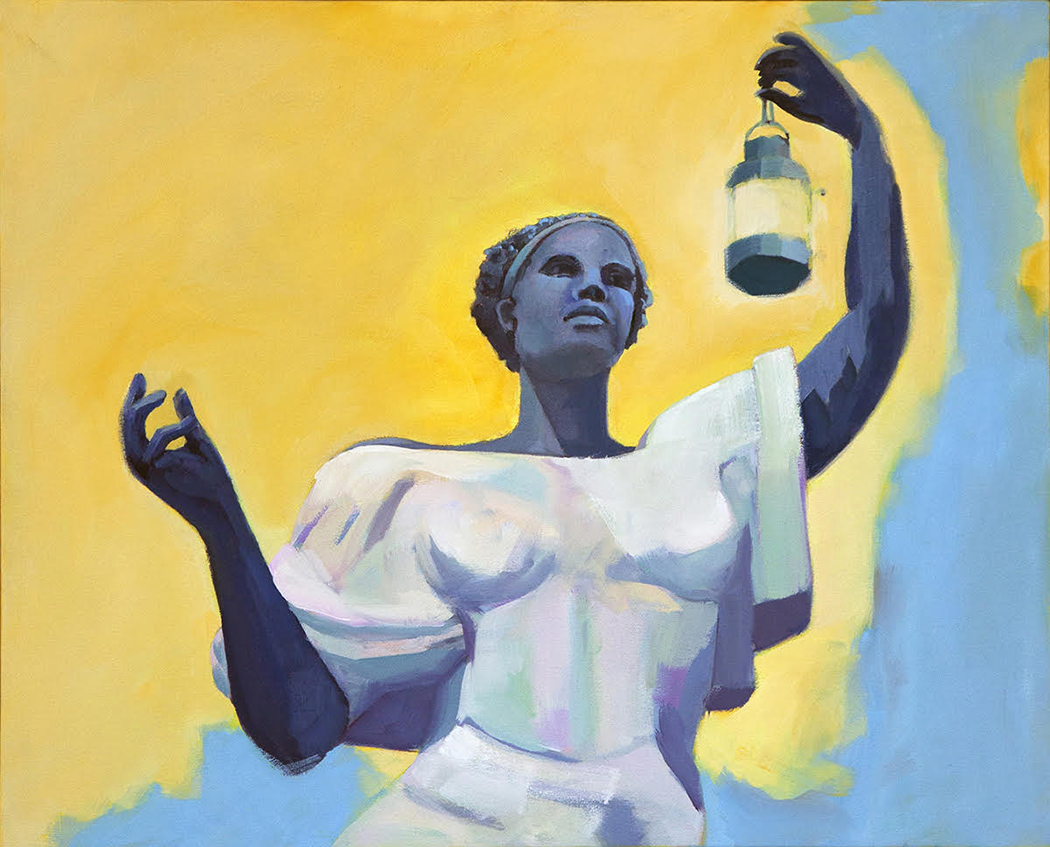By Sarah Sargent
According to Greek mythology, Hades, lord of the underwold, fell in love with Persephone, the daughter of Demeter, the goddess of the harvest. Hades kidnapped Persephone and pulled her down to his subterranean kingdom, until Zeus intervened and freed her. During her time in the underworld, however, Persephone ate a handful of pomegranate seeds. Because she’d tasted the food of the dead, she was forced to return for a few months every year. During those months, Demeter became sad, leaving the earth barren and causing winter. Persephone’s annual ascent would cheer her mother up again, bringing spring.
“Persephone Ascending: A Multi-site Group Show of Virginia Women Artists” at Chroma Projects/Vault Virginia, Studio IX, and a number of storefront windows along the Downtown Mall and off Harris Street, presents different voices, viewpoints, and interpretations of the myth. (A full list of artists in the show can be found at chromaprojects.com.)
“When I started planning this, the Downtown Mall was full of empty storefronts,” says Chroma Projects Director Deborah McLeod. “Walking along and seeing all that sadness and dearth, it just pulled you down.” Expanding the exhibition into those vacant places seemed like the perfect antidote, but managers of the unleased spaces were hesitant to display work that might turn off potential lessors. So McLeod turned to businesses to display the work. These include Water Street Studios (Renee Balfour), C-VILLE Weekly (Bolanle Adeboye), Silverchair (Barbara MacCallum), 2nd Act Books (Rose Guterbock), My Dance Shoppe (Megan Hillary), Uplift Thrift (Nina Burke), and Rethreads (Dawn Hansen and Ann Ray).
Naturally, pomegranates figure largely in the show. Susanne Arnold uses an actual one to form her figure’s body in “Persephone Rising.” Linda Wachtmeister’s halved pomegranate (“Consequential”) references Persephone’s bifurcated existence. A reduced palette of hot pinks and grays and a graphic style make the images pop. Undulating lines dotted with white seed-like shapes pulse away from the pomegranate, suggesting the ripple effect of Persephone’s consumption.
Alexandria Searls’ stunning photo collage, “The Face of Persephone,” has an appealing hard-candy lusciousness. The composition depicts a dangling plastic baggie containing two pomegranates. As if emanating from it, a miasma of fleeting images, including Persephone’s face, hovers above. The blurry collage contrasts elegantly with the crystalline quality of the shiny, red pomegranates sheathed in translucent plastic.
How do you point out the entrenched racism and subjugation of women that exists within the world of classical ballet? With adorable little ballerina apples dancing across a stage. Megan Hillary’s “Of Pomegranates and Freshly Peeled Apples” alludes to a George Balanchine quote that describes how a dancer’s skin should be as pale as the flesh of an unskinned apple, i.e. never exposed to sun. While excluding dancers of color altogether, the quote also sets up parallels between Balanchine’s sun-deprived dancers and Persephone, who is also kept away from the sun by a powerful, controlling male. Hillary likens the rising of Persephone to the strides that have been made in ballet, as evidenced by toe shoes on the periphery of the piece that hail the (shockingly recent) introduction of different skin tone-hued ballet slippers.
Chuxin Zhang’s poignant “Emergence” uses a found piece of driftwood with silver and white clay to depict Persephone’s/spring’s return. The snow that has encased the figure is melting and breaking apart, leaving little drifts that trail behind her. You can see wings tightly folded at her side as within a chrysalis—a suggestion that she will soon fly away and soar.
Other works less literally tied to Persephone’s story include the breaking laces of the corset, which represent the casting off of the trammels of female confinement, in Michelle Gagliano and Beatrix Ost’s “The Persimmon Burst.” Rosamond Casey’s “The Something Else that Had Been Lurking All Along Beneath the Thing that Was” exudes a distinct malevolence that dovetails with our idea of the underworld. There’s a decidedly corporal quality to the rent and moist looking “ductwork” that runs up through the center of the piece. One thinks of an esophageal tunnel, a discarded chrysalis, the interior of a stem, or perhaps Persephone’s route back from Hades ripped open by her flight.
Polly Breckenridge and Allyson Mellberg-Taylor attack the prompt through the aesthetic of vintage commercial art. It is quiet, but it packs a punch. Breckenridge’s “Qui Tacet Consentire Videtur” (they who are silent, appear to consent) pairs drawings of girls in different poses, possibly taken from some kind of manual on the human figure or pattern book, together with a variety of the patronizing things men (mostly) say to women and girls. Breckenridge uses glitter, a childish pencil scrawl, and smudged erasures to drive home the point that this indoctrination starts early.
Mellberg-Taylor’s message may be more oblique, but we see in the contemptuous gaze of the woman in “The Radish Cycle” someone who’s not going to take any shit from anybody despite what you might think of her overabundant collar of leaves. Mellberg-Taylor’s women seem to maintain their equanimity (and power) in spite of the strange circumstances they find themselves in.
Persephone ascending back into the world is a celebration of the return of spring. It takes on enhanced significance this year as we emerge from the winter of COVID-19 into a vernal season full of promise, thanks to vaccines. And of course, as these artists have shown us, Persephone is a potent allegory of female empowerment whose relevance continues today.



